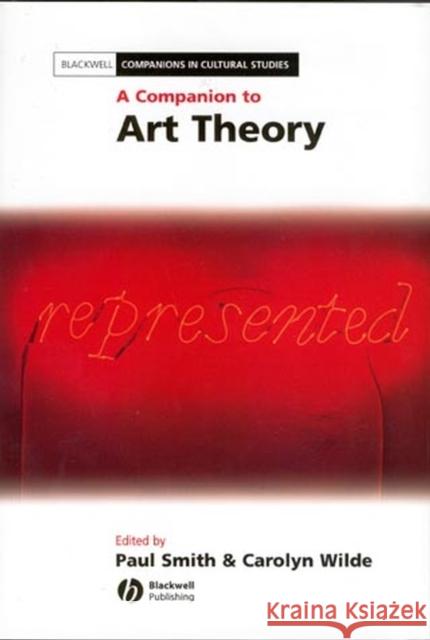A Companion to Art Theory » książka



A Companion to Art Theory
ISBN-13: 9780631207627 / Angielski / Twarda / 2007 / 552 str.
A Companion to Art Theory
ISBN-13: 9780631207627 / Angielski / Twarda / 2007 / 552 str.
(netto: 837,40 VAT: 5%)
Najniższa cena z 30 dni: 873,85
ok. 30 dni roboczych
Dostawa w 2026 r.
Darmowa dostawa!
The Companion provides an accessible critical survey of Western visual art theory from sources in Classical, Medieval and Renaissance thought through to contemporary writings.
Wydanie ilustrowane
Plates ix
Notes on Contributors x
Preface xvi
Part I: Tradition and the Academy 1
Introduction: Alberti and the Formation of Modern Art Theory 3
Carolyn Wilde
1 The Classical Concept of Mimesis 19
Göran Sörbom
2 Medieval Art Theory 29
Hugh Bredin
3 Neoplatonist Aesthetics 40
Suzanne Stern–Gillet
4 Renaissance Art Theories 49
François Quiviger
5 Touch, Tactility, and the Reception of Sculpture in Early Modern Italy 61
Geraldine A. Johnson
6 The Spiritual Exercises of Leonardo da Vinci 75
Robert Williams
7 Academic Theory 1550 1800 88
Paul Duro
8 Rhetorical Categories in the Academy 104
Caroline van Eck
9 The Picturesque and its Development 116
Andrew Ballantyne
Part II: Around Modernism 125
10 The Aesthetics of Kant and Hegel 127
Jason Gaiger
11 E. H. Gombrich and the Tradition of Hegel 139
David Summers
12 German Romanticism and French Aesthetic Theory 150
Wendy S. Mercer
13 Expression: Natural, Personal, Pictorial 159
Richard Shiff
14 Reading Artists Words 173
Richard Hobbs
15 Nietzsche and the Artist 183
Michael White
16 Wittgenstein, Description, and Adrian Stokes (on Cezanne) 196
Paul Smith
17 Modernism and the Idea of the Avant–Garde 215
Paul Wood
18 On the Intention of Modern(ist) Art 229
Fred Orton
19 Anti–Art and the Concept of Art 244
Paul N. Humble
20 Marcel Duchamp s Readymades and Anti–Aesthetic Reflex 253
David Hopkins
Part III: Critical Theory and Postmodernism 265
21 Marxism and Critical Art History 267
David Craven
22 Walter Benjamin and Art Theory 286
Howard Caygill
23 Bakhtin and the Visual Arts 292
Deborah J. Haynes
24 Peirce s Visuality and the Semiotics of Art 303
Michael Leja
25 Conceptual Art 317
Charles Harrison
26 Barthes on Art 327
Margaret Iversen
27 Foucault and Art 337
Roy Boyne
28 Derrida and the Parergon 349
Robin Marriner
29 What Consciousness Forgets: Lyotard s Concept of the Sublime 360
Renée van de Vall
30 Deleuze on Francis Bacon 370
Ian Heywood
31 Feminisms and Art Theory 380
Marsha Meskimmon
32 Psycho–Phallus (Qu est–ce que c est?) 397
Mignon Nixon
Part IV: Interpretation and the Institution of Art 409
33 The Rules of Representation 411
John Willats
34 Gombrich and Psychology 426
Richard Woodfield
35 Hermeneutics and Art Theory 436
Nicholas Davey
36 Reciprocity and Reception Theory 448
Michael Ann Holly
37 The Paradox of Creative Interpretation in Art 458
Carl Hausman
38 Interdisciplinarity and Visual Culture 467
Charlotte Klonk
39 Against Curatorial Imperialism: Merleau–Ponty and the Historicity of Art 477
Paul Crowther
40 The Institutional Theory of Art: Theory and Antitheory 487
Garry L. Hagberg
Index 505
Paul Smith is Chair of the History of Art department at the University of Warwick. His previous publications include Impressionism: Beneath the Surface (1995), Interpreting Cézanne (1996) and Seurat and the Avant–Garde (1997).
Carolyn Wilde is now retired and was formerly Senior Lecturer in Philosophy at the University of Bristol. Her publications include articles on philosophical aesthetics, the most recent of which is ′Style and Value in the Art of Painting′ in Richard Wollheim on the Art of Painting, edited by Rob van Gerwen, 2001.
This survey of art theory in the context of Western visual art consists of 41 original essays written by experts in the field. Following an extensive introduction on the formation of modern art theory, the
Companion is organized chronologically so that readers can trace developments of visual art theory, from classical and medieval sources and modern conceptions of art as they have been theorized since the Renaissance, through to some current theoretical preoccupations.
In addition to outlining and describing various theoretical positions, the book′s chapters articulate some assumptions that underpin them and raise more general questions about the nature of theorizing about art. In this way the Companion provides both an introduction to main themes of Western art theory and a source for critical enquiry into the purposes, possibilities and limitations of theory in the context of artistic practice.
The work can also be used alongside the three Art in Theory anthologies published by Blackwell, as a further art theory resource.
1997-2025 DolnySlask.com Agencja Internetowa
KrainaKsiazek.PL - Księgarnia Internetowa









